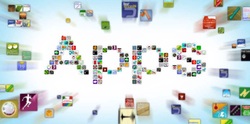
A mobile application (or mobile app) is a software application designed to run on smartphones, tablet computers and other mobile devices. They are usually available through application distribution platforms, which are typically operated by the owner of the mobile operating system, such as the Apple App Store, Google Play, Windows Phone Store, and BlackBerry App World. Some apps are free, while others must be bought. Usually, they are downloaded from the platform to a target device, such as an iPhone, BlackBerry, Android phone or Windows Phone, but sometimes they can be downloaded to laptops or desktops. For apps with a price, generally a percentage, 20-30%, goes to the distribution provider (such as iTunes), and the rest goes to the producer of the app. The term “App” became popular in 2010.
Mobile apps were originally offered for general productivity and information retrieval, including email, calendar, contacts, and stock market and weather information. However, public demand and the availability of developer tools drove rapid expansion into other categories, such as mobile games, factory automation, GPS and location-based services, banking, order-tracking, and ticket purchases. The explosion in number and variety of apps made discovery a challenge, which in turn led to the creation of a wide range of review, recommendation, and curation sources, including blogs, magazines, and dedicated online app-discovery services.
But it was only with the advent of the Apple iPhone and soon to Android phones and other smartphones was the possibility of installing applications on mobile devices, broad sections of the population more common, supported by corresponding amplified marketing the manufacturer. There are now hundreds of thousands of apps. They are available for a variety of areas, such as office applications, games, guides, sports apps, for the Emulation of older home computers and programmable calculator, as support for diabetics and more.
The popularity of mobile applications has continued to rise, as their usage has become increasingly prevalent across mobile phone users. A May 2012 comScore study reported that during the previous quarter, more mobile subscribers used apps than browsed the web on their devices: 51.1% vs. 49.8% respectively. Researchers found that usage of mobile applications strongly correlates with user context and depends on user's location and time of the day. According to ABI Research the mobile app market will value at $27 billion in 2013.
App Revenue Forecast
Mobile app revenue was huge last year, but that'll be nothing compared to where it's expected to go by 2016.
In 2016, total global mobile application revenue will reach an estimated $46 billion, according to ABI Research. That figure, the research firm says, includes pay-per-download, in-app purchases, subscriptions, and advertising. Last year, mobile app revenue hit $8.5 billion, ABI research says.
This year, in-app purchases will likely outpace pay-per-download revenue, but according to ABI Research, the number of people buying content in apps won't grow all that much, potentially putting that revenue opportunity's future in doubt.
 RSS Feed
RSS Feed